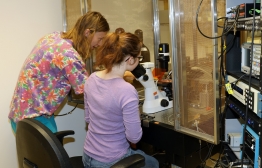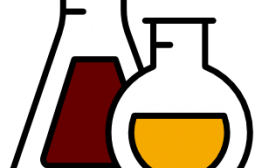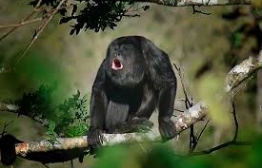As a Loyola student, you have the opportunity to work alongside our talented professors to partner in collaborative research. Learn more about some recent research and projects currently underway.
Materials for Spintronic Devices
Spintronics (spin+electronics) is a multidisciplinary research field that uses the magnetic (spin) and electronic properties of magnetic materials to develop devices. Spintronic devices are used in magnetic memories and sensors such as hard disk drive, STT-MRAM, and digital compass (used in navigation systems). Physicists work with engineers (electrical, mechanical, mechanical, chemical engineers) and material scientists in designing and developing such devices and improving their performance. Moreover, the demand for smaller, faster, more reliable, and more energy-efficient devices is only increasing, emphasizing the importance of this research.
Dr. Beik Mohammadi and her research group use numerical and experimental techniques to investigate magnetic systems for spintronics applications. Currently, a GPU accelerated simulation package (called Mumax) is used to perform micromagnetic simulations. In addition, experimental research is performed in collaboration with the University of New Orleans. These studies aim to understand the interplay of magnetic properties and how they affect the performance, speed, and energy consumption of spintronic devices.
Current student researchers working on this project:
Elliott Clay, 2019-present
Former student researchers working on this project:
Jonathan Andino, 2020
Related publications:
J. Beik Mohammadi and A. D. Kent: Spin-torque switching mechanisms of perpendicular magnetic tunnel junction nanopillars, Applied Physics Letters 118, 132407 (2021)
N Statuto, J Beik Mohammadi, AD Kent: Micromagnetic instabilities in spin-transfer switching of perpendicular magnetic tunnel junctions, Physical Review B 103 (1), 014409 (2021)
Reduced Exchange Interactions in Magnetic Tunnel Junction Free Layers with Insertion Layers, ACS Applied Electronic Materials 1 (10), 2025-2029 (2019)
J. Beik Mohammadi, K. Cole, T. Mewes, C. K. A. Mewes: Inhomogeneous perpendicular magnetic anisotropy as a source of higher-order quasistatic and dynamic anisotropies, Physical Review B 97 (1), 014434 (2018)
Biophysics
All living cells in order to survive and to perform their physiological functions continuously exchange various atoms and molecules with the extracellular medium. Of particular importance are ions such as sodium, potassium, or calcium. Their controlled exchange with the extracellular medium is crucial to action potentials in neurons, muscle contraction, etc. Since the cellular membrane is normally impermeable to ions, their exchange is facilitated by special proteins called the ion channels, which are embedded in the membrane and form gated microscopic pores.
The focus of our research is to better understand the function of these proteins and their nonequilibrium properties. We know they can detect certain environmental factors, such as changes in electric field, presence of cer
tain ligands or even mechanical stress, and can open or close in response to these factors (ion channel gating). This way they can control and regulate various physiological processes. We use the experimental technique of patch-clamping and recent advances in mathematics and statistical physics to better characterize and control the process of channel gating. We also look at the interaction of inorganic nanoparticles, e.g. multiferroic nanoparticles, with biological cells.
Current Projects:
- Remote control of voltage-sensing biological macromolecules using multiferroic nanoparticles - with L. Malkinski (University of New Orleans)
- Conductance hysteresis in ion channels
- Experimental detection of nonequilibrium kinetic focusing in voltage-gated ion channels
- Optimization of wavelet-based voltage protocols for ion channel electrophysiology
- Quantum biology - modeling photosynthesizing complexes in plants - with L. Celardo (University of Puebla, MX)
Undergraduate Research:
Biophysics research combines experiments, computations, and theoretical analysis. Student researchers in the Biophysics lab can choose between doing experiments (preparing biological samples, performing patch-clamping experiments) and computational work (analysis of raw experimental data generated from patch-clamping experiments, simulation of ionic currents, and building models of channel gating kinetics). Our experiments use modern ion channel electrophysiology methods, such as the patch clamping technique. The lab is equipped with two patch-clamping stations, one of which is devoted to student training. Most of the numerical simulations are done using MATLAB.
Current members of the lab are:
- Brad Kerkhof
Former lab members:
- Kimiasadat Mirlohi (Physics'22)
- Megan Adamson (Physics'21)
- Ariel Hall (Physics'20)
- Cole Green (Physics'20)
- Kaough Baggett (Physics'18)
- Ilyes Benslimane (Physics'17)
- Antonio Ayala (Physics'17)
- Dustin Lindberg (Physics'14)
- Douglas Alexander (Physics'14)
- Michael Kammer (Physics'12)
- David Vumbaco (Physics'12)
- Warner Sevin (Physics'11)
- Stella von Meer (Physics'09)
- Meagan Relle (Biology'08)
Recent publications from the Lab:
- A. Kargol: "Introduction to Cellular Biophysics. Vol. II. From membrane transport to neural signaling". IOP Concise Physics, Morgan & Claypool Publishers 2019
- A. Kargol: "Introduction to Cellular Biophysics. Vol. I. Membrane transport mechanisms". IOP Concise Physics, Morgan & Claypool Publishers 2018
- A. Kargol, L. Malkinski, R. Eskandari, M. Carter, D. Livingston: “Cellular Defibrillation”: Interaction of Microscale Electric Field with Voltage Gated Ion Channels. J. Biol. Phys. (2015)
- A. Ayala, J.D. Alexander, A.U. Kargol, L. Malkinski, A. Kargol: Piezoelectric micro- and nanoparticles do not affect growth rates of mammalian cells in vitro. J. Bionanosci. 8 (2014) 309-312
- L. Ponzoni, G.L. Celardo, F. Borgonovi, L. Kaplan, A. Kargol: Focusing in Multiwell Potentials: Applications to Ion Channels. Phys. Rev. E 87 (2013) 852137
- A. Kargol: Wavelet-based protocols for ion channel electrophysiology. BMC Biophysics 6:3 (2013)
- A. Kargol, L. Malkinski, G. Caruntu: Biomedical applications of multiferroic particles. In: Advanced Magnetic Materials, InTech (2012)
- A. Kargol, M. Kargol: Passive transport processes in cellular membranes. In: Porous media: Applications in biological systems and biotechnology, Taylor and Francis Group, LLC (2011)
Forensic Chemistry
Dr. Duggar’s research emphasizes the use of traditional tools and techniques to yield more discriminating scientific data, and the determination of the pragmatic applicability of research-laboratory-based results on real-world samples. Particular areas include SEM-EDS analysis of particulate transfer evidence and the study of the persistence and significance of trace evidence in an urban environment.
Making a better world: A project examining motivation to improve collective well-being
Dr. Chuck Nichols' project seeks to better understand the correlates, causes, and effects of wanting and working toward collective betterment. Caring about and helping close others and even complete strangers can provide strong psychological benefits for the helper as well as the helped. However, some surveys suggest that individuals may be becoming more selfish and less other-focused in recent decades, potentially undermining overall well-being. This project employs survey and experimental methodology to explore what leads people to care about and act to help others.
Social and Biological Influences on Primate Behavior and Reproduction
Dr. Evan Zucker, Professor of Psychology, studies the social and biological influences on the behavior and reproductive outcomes of nonhuman primates, as well as studying naturally-occurring patterns of human behavior (human ethology) and other aspects of social phenomena. His recent research has focused on the relationship between familial social status and life-history variables, as well as how indices of health in black howling monkeys are related to ecological factors, group composition factors, and reproductive status.
Virtual Reality Simulations for Physics Education
When studying physics, we can study large systems (such as free fall under gravity or even galaxies) or small systems such as atoms in a crystal. For many technological applications, it is essential to study the property of matter rooted in the arrangement of atoms in solids. Solid-state physics is a branch of physics that focuses on how the arrangement of atoms can lead to different (electrical, magnetic, mechanical, etc) properties of materials. This is critical when looking for materials to advance the current technologies or to propose new solutions. In real life, physicists and engineers investigate small-scale physics (for example, using advanced transmission electron microscopy techniques). They measure properties of that same system and try to come up with theories that build the bridge between the arrangement of atoms and the properties that we can measure in the lab (for example, electrical resistance). One challenge that all of us face when doing this kind of research is the three-dimensional visualization of atomic structures. Our books, our notes, even monitors provide two-dimensional visuals...
Dr. Beik Mohammadi and her research team use virtual reality (VR) simulations to developed interactive three-dimensional structures to enhance solid-state physics education. Using such models helps us dive deeper into the three-dimensional word of atoms in a fun interactive way! The hope is to teach solid-state physics to physics and even non-physics majors!
Current student researchers working on this project:
Joshua Leaney, 2021-present
Former student researchers working on this project:
Justin Chang
Related publications:
J Beik Mohammadi, J Seefeldt: Virtual Reality Simulations for Solid State Physics Education, Bulletin of the American Physical Society 65 (2020)
Quantum Optics
Experiments using light quanta – photons – have proven to be very effective probes of a large range of phenomena, including quantum entanglement. This phenomenon has long fascinated scientists, and exemplifies the mystery and ‘weirdness’ of quantum physics. It also points the way towards the possibility in the future of extremely powerful quantum computers.
In the Quantum Optics Lab in the Physics Department at Loyola University we have done a successful version of a test of Bell's Theorem using entangled photons. Our results violate an inequality -- known as the Clauser, Horne, Shimony, Holt (CHSH) inequality -- to a high degree of confidence. These results are in agreement with the laws of quantum mechanics, but inconsistent with any 'hidden variable' extension which attempts to impose locality.
Students are involved in all aspects of the work, from putting together and aligning optical components, to building electronics, to using computers to acquire, analyze and model the data. We have automated most aspects of the experiment and are currently pursuing a variation of the initial experiment.
Current students:
Brad Kerkhof (Phys '22)
Former students:
Spencer Stingley (Phys '21)
Grace Heath (Phys '21)
Nicholas Neal (Phys '20)
Sandrine Ferrans (Phys '19)
John Whyte (PHYE '18)
Andrew Eddins (Phys '18)
Kyra Woods (Phys '17)
Cody Smith (Phys '17)
Joseph Hyde (Econ '17)
Richard Bustos (Phys '16)
Gravitational Physics
There is a long history in gravitational physics at Loyola. Professor Emeritus Carl Brans is world-renowned for his development of the scalar-tensor theory of gravity. Known as the Brans-Dicke theory, this modification/extension of Einstein’s theory of General Relativity is still very relevant, and generates a lot of interest, particularly in cosmology, even today. Carl’s collaboration with the Torsten Asselmeyer-Maluga resulted in their book, Exotic Smoothness and Physics, which surveys extensively exotic differentiable structures on 4-dimensional manifolds and their potential impact on physical theories involving spacetime models.
Former Loyola faculty member Tirthabir Biswas also worked in the area of gravitation and cosmology. He collaborated with a number of Loyola students over the years on theoretical ideas in gravitation with implications for cosmology.
Professor Martin McHugh worked for many years on the experimental side of gravitation. First in tests of the equivalence principle, then in the effort to detect gravitational waves. He worked on resonant mass gravitational wave detectors, then with interferometers when he joined the LIGO Science Collaboration. After being part of that group for nearly 10 years he left to pursue other research interests. However, he was quite gratified when LIGO made the first direct detection of gravitational waves, reported in 2016. That work led to the Nobel prize for the leaders and founders of the project, and gravitational waves have become a tool to study astrophysics, cosmology, and as a probe to a better understanding of the gravitational interaction.
Finally, Professor McHugh has done some work in the history of gravitational physics, in particular the pioneering work of Robert H. Dicke. Dicke made significant contributions in many areas of physics over the second half of the twentieth century. A short list of his accomplishments include the invention of the microwave radiometer, work in atomic physics on the narrowing of spectral lines by use of a buffer gas (sometimes referred to as ‘Dicke narrowing’), and foundational work on the theory of superradiance. But Dicke is best known for his work in gravitational physics – both his pioneering experiments, and his role in the development of the Brans-Dicke theory. The latter, as noted above, done with Loyola Professor Emeritus Carl Brans when he was a graduate student at Princeton. Dicke also played a pivotal role in the discovery of the Cosmic Microwave Background.
Senior Capstone Projects
All majors in French, Latin American Studies, and Spanish prepare a senior Capstone project which is normally presented during their last semester at Loyola. Projects vary greatly, from literary analysis, to concerts, to social research, or whatever makes sense with the student's background and interests. For some examples, click here.
Biochemistry
Dr. Walkenhorst is a physical biochemist whose research involves studying the structure, function, and stability of peptides and proteins in solution. He uses chemical, biological, and instrumental techniques to study several classes of proteins. His most recent project involves studying the effect of environmental factors such as pH, ionic strength, toxic ions, and surface type on the activity of a new class of membrane active antibiotics called antimicrobial peptides. He conducts research with undergraduate students interested in careers in biochemistry and medicine. Dr. Walkenhorst is a founding member of the New Orleans Protein Folding Intergroup (NOProFIG) which began in January 1999 and meets every two weeks to discuss research results of local researchers in related fields.
Dr. Walkenhorst's work has been published in journals such as Antimicrobial Agents and Chemotherapy, Biochemica Biophysica Acta: Biomembranes, Biochemistry, Journal of Molecular Biology, Protein Science, Journal of the American Chemical Society, Analytical Chemistry, and Protein Engineering.
For more information, contact William Walkenhorst, Ph.D., at walken@loyno.edu
Research in the Schoeffler Lab centers on exploring the sequence-structure-function paradigm as it relates to enzyme specialization. This means we're interested in understanding how changes at the genetic level lead to functional changes in proteins, optimizing them for particular jobs or particular environments. We study “interesting systems with hidden differences”: DNA modification enzymes that work at either near-boiling or near-freezing conditions, RNA modification enzymes that have the same shape but recognize dramatically different biochemical targets. In studying these systems, we ask: What small differences at the atomic level are driving these big differences in the macromolecule, and thus the organism? To interrogate these relationships, we use tools from computational biochemistry and bioinformatics, biochemistry, and structural biology. Our work is basic in nature but has implications for big problems like antibiotic resistance, bioengineering, and the search for extraterrestrial life.
Find out more about our work at the Schoeffler Lab website (Loyola login required):
https://sites.google.com/loyno.edu/schoefflerlab/home
Students interested in working in the lab should contact Dr. Schoeffler by email (ajschoef@loyno.edu). Some of our lab meetings are open-attendance; any interested Loyola student can ask for and receive an invitation to “sit in” and learn more about the lab by contacting Dr. Schoeffler.









